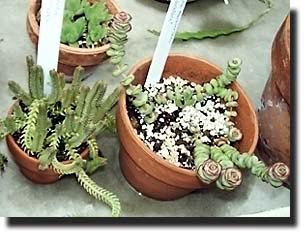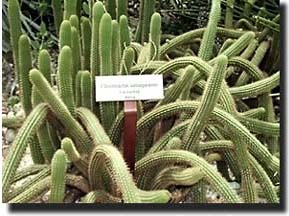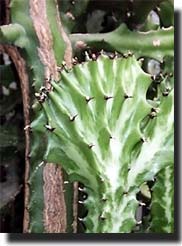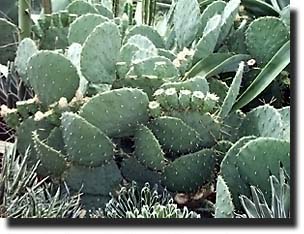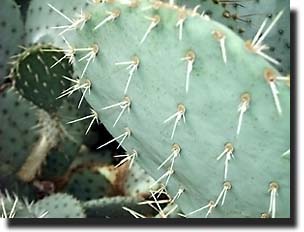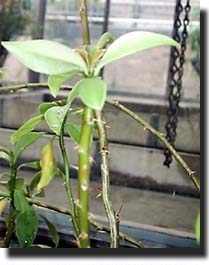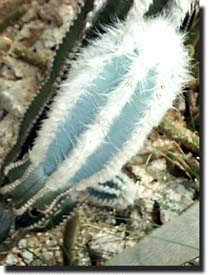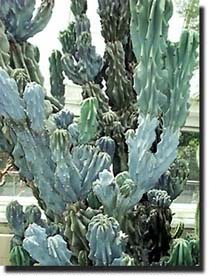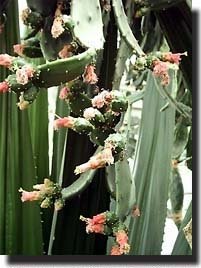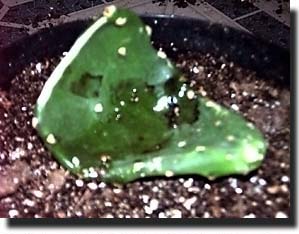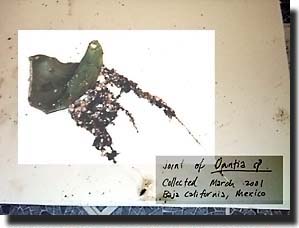
From Areoles to Zygocactus: An Evolutionary Masterpiece
A Synopsis of the Family Cactaceae by Aaron M. Socha
Introduction to the Botany of Cactaceae
Traditional and Modern Uses of the Cactus
Biographical Sketch of Joseph Nelson Rose; co-author of "The Cactaceae"
For thousands of years, people utilized
cacti and other fleshy, "succulent" plants as valuable sources of food and
medicine, as elements of religious ceremony and for landscaping. Unique in
tolerance, structure, and habit, these plants grow wild from Patagonia, Argentina,
to the Acropolis in Athens. Today, endemic, exotic, and cultivated species
of succulent plants are still used by corporations, farmers, consumers, and
tribepeople worldwide. Some of these plants are true cacti, while others
are often mistakenly referred to as cacti. The family Cactaceae (the
cacti) can be distinguished from other succulent plants by distinct morphological,
taxonomic, biological and phytochemical
characteristics.
|
|
|
By definition, a succulent is any plant that accumulates water in fleshy, water-storing shoots, leaves, or roots, and exhibits a juicy or fleshy textural appearance. Families that contain many succulent species include the Euphorbiaceae (many species of which yield latex), Agavaceae (species of Agave used to make tequila, mezcal, and paper), and Asphodelaceae (Aloe). |
|
|
|
|
The family Cactaceae, of the order Caryophyllales, has been systematically classified based on the hypothesis that spines evolved from leaves and that the ancestral species contain a combination of the two. The most useful diagnostic characteristic of the family is the areole, which occurs in all cacti and no other plants. Furthermore, the genus Opuntia is distinguished by glochids and/or roots borne on the areoles. The following sub-families provide a useful outline of the family's structure. I. Pereskioideae- leaves broad, no glochids (genera = Maihuenia, Pereskia) II. Opuntioideae- leaves +/- terete (having circular cross-section), glochids present (genera = Opuntia, Pereskiopsis, Pterocactus, Quiabentia, Tacinga) III. Cactoideae- no leaves, no glochids (all other genera, including Cereus, Hylocereus, Echinocereus, Pilosocereus, Cleistocactus, Carnegiea, Ferocactus, Lophophora, Mammillaria, etc.,are grouped here.) |
| Completed in full only when water and nutrients are abundant, the life cycle of cacti is also interesting. The plants are most commonly monoecious (male and female organs on same plant), and pollinated either by day or night (depending on species) by hummingbirds, bees, bats, or hawkmoths. Their most frequent method of reproduction is by seed, which is initially located in the fleshy pulp of the fruit. Though this ripening medium may seem ideal for their germination, the seeds must be dispersed. This characteristic is not unique to cacti, however; other fleshy fruits such as tomatoes and melons also contain seed growth inhibitors within their pulp, therefore requiring a mediated dispersal. Once washed from the pulp, cacti seeds retain their viability for quite some time and may remain in a state of dormancy until conditions become suitable enough for development. Since germination occurs at slightly higher temperatures (approx. 21°C), seedlings tend to naturally develop in the summer months, most productively in wet soil. In some species, the seed coat is extremely hard and must be abraded either by sand or by acids found inside the gut of an animal vector. Since animal feet often wander further than cacti fruits roll, this seemingly excessive dispersion method actually broadens the evolutionary possibilities and distribution of the family. |
|
|
Due to their aggregate growth patterns, their adaptions to asexual reproduction, and their tendency to form hybrids in nature, Opuntia species are often triumphant in many harsh, new environments. Opuntia ficus-indica, for example, has been cultivated for its fruit since prehistory and is now found commonly as an escape from the Mediterranean to South Africa, Australia to Hawaii and California. Confirmed by the chemical evidence of Benson & Walkington (1965), hybrid "swarms" of O. occidentalis (probably formed by the natural crossbreeding between O. ficus-indica (native to Mexico) and O. littoralis (native to California)) can account for some of the success of the genus in California. These hybrids have evolved morphological characteristics, such as enlarged, less glaucous joints and deeper roots, allowing them to inhabit warmer, less arid land. Opuntia species may also reproduce asexually by detaching joints whose meristematic areoles grow roots. Not only is this an extremely efficient method of reproduction it often assures survival in adverse conditions. Philip Munz (1938) noticed that the California variety of O. ficus-indica is found in most abundance in areas where soils have been disturbed by floods. This success is due to the fact that the detached joints float along a current of water and form roots upon finding land. Named for its Spanish agricultural fathers (who brought the original parent plants, O. ficus-indica and O. megacantha, to San Diego in 1769), the "mission cactus" (Opuntia occidentalis) also has a tendency to grow in massive thickets in drier regions of Southern California. Forming these protective clusters, that allow the thick cuticle to act as surrounding armor, these evolutionary jewels survive the frequent conflagrations of the area. Fires that often destroy all neighboring grasses and other native species burn no more than a few spines of the cacti. |
|
|
Cacti have also been used to form novel horticultural hybrids. Using the acclimated roots and shoots of cacti as a base, cultivators have successfully grafted on shoots from plants in families such as Solanaceae (tomatoes, potatoes), Cucurbitaceae (gourds, melons, squash), and the sub-family of Rosaceae, Pomodideae. Unfortunately, the roots of these grafts often grow no further than the fleshy parenchyma tissue of the cactus and fail to produce a seed.
The cacti, and other succulents like the stonecrops (family Crassulaceae), utilize a method of carbon dioxide fixation within their photosynthetic parenchyma cells known as crassulacean acid metabolism (CAM). All other plants photosynthesize by directly exchanging the necessary gas, carbon dioxide, with the environment through their diurnally open stomates (tiny apertures on leaf surfaces that exchange water and gas with the environment). Because of the dry, usually hot environment where they live, CAM plants are forced to close their stomates during the day to prevent water from evaporating. (Since the molecular weights of CO2 (44g/mol) and H20 (18g/mol) differ significantly, water diffuses much faster across a gradient, and would be lost at a rate that would kill certain plants (i.e., succulents) that do not have abundant reserves). With stomates that are closed during the day, no water or CO2 is exchanged and a new mechanism is required for productive photosynthesis. CAM plants, instead, open their stomates and fix CO2 within their cells at night, and then rely on thermodynamic chemical reactions to store and convert the CO2 for use during the day. The ability to fix carbon dioxide during dark hours is due to the activity of the enzyme, PEP carboxylase (occurring in the cytosol). This enzyme converts the nocturnally attained CO2 to an organic acid (such as malic or isochloric acid) for storage in the cell's vacuole until the morning. With the heat energy of the day, the equilibria within the plant's cells are shifted, and the organic acid product of nighttime CO2 uptake is then decarboxylated into carbon dioxide. This chemistry is why CAM plants taste sour at night and sweet during the day. After this thermoperiodic process, the CO2 is then transferred to the five-carbon sugar, ribulose 1,5 bisphosphate, beginning the Calvin cycle. Here, the process of photosynthesis begins within the same cell that generated the CO2, making for a very efficient system of growth and development. Warm nights, however, cause the organic acids to be converted to useless CO2 because no photosynthesis can occur without light. This is the reason why many cacti are so slow growing.
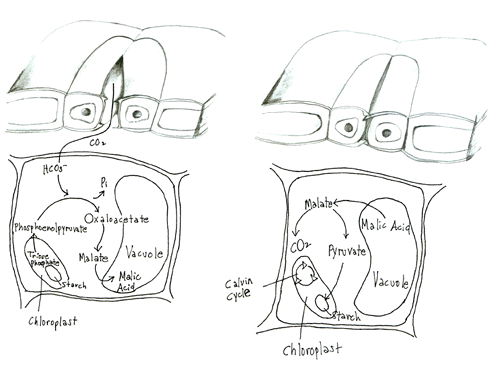 At night
(left), CO2 is
fixed via open stomates while starch from the chloroplast is broken down to
phosphenolpyruvate (PEP). The CO2 undergoes hydration
to from the bicorbonate ion (HCO3-), which reacts with
PEP forming oxaloacetate. Oxaloacetate is reduced to form malate, and then
pumped into the vacuole. There, it is stored as malic acid until the morning.
At night
(left), CO2 is
fixed via open stomates while starch from the chloroplast is broken down to
phosphenolpyruvate (PEP). The CO2 undergoes hydration
to from the bicorbonate ion (HCO3-), which reacts with
PEP forming oxaloacetate. Oxaloacetate is reduced to form malate, and then
pumped into the vacuole. There, it is stored as malic acid until the morning.
When the plant cell is heated by the sun (right), the vacuole expels malic acid which is then decarboxylated. The products of this reaction, CO2 and pyruvate, act on the chloroplasts. CO2 is fixed by Rubisco in the Calvin cycle, and pyruvate undergoes reverse glycolysis to form starches and sugars.
The phytochemistry of the cacti is also distinct. They contain rare primary compounds and unique secondary metabolites. First, the pigment compounds known as betacyanins (or betalains) are found in only a few orders of flowering plants. All other angiosperms contain either flavanoids, flavonols, or anthocyanins. Betacyanins are reddish compounds of the fruits and flowers, which are similar to anthocyanins but more complex due to their aromatic (nitrogen-containing) constituents. Other than in the cacti, betacyanins are found in the Chenopodiaceae (goosefoot and beet) and Portulacaceae (portulaca) families. The cacti also contain alkaloids, small organic compounds containing heterocyclic nitrogen. These secondary metabolites, derived from amino acids and used to move nitrogen throughout the plant, serve allelopathic functions to deter competing plants and plant eaters. Accumulating over time, they are found in highest potencies in the older plants. Because alkaloids are often bitter-tasting and or poisonous, many herbivores would rather starve than eat plants containing them. Also, since alkaloids are expelled through the plant' s roots, many nearby plants are outcompeted for light and water because they are chemically unable to process the toxins produced by their neighbors. There are, however, certain organisms (usually humans) that can metabolize these compounds and often enjoy them! Caffeine, nicotine, cocaine, and all hallucinogenic drugs contain alkaloids. Mescaline, the most commonly known alkaloid produced by the cacti, has been used in traditional religious settings by North and South American Indian tribes for thousands of years. It and other recreational and medicinal cacti will be discussed in the next section.
|
Scientific name Vernacular name |
Plant description |
Origin, distribution, and
cultivation
|
Medicinal and Traditional
Uses |
|
Carnegiea
gigantea (Engelmann)
Sahuaro, |
Simple upright stem, up to 12 meters. Ribbed branches (8-12), bearing spines from top to bottom, diurnal flowers and fruits at top. | Endemic to Arizona, southeastern California, and Sonora, Mexico. | The plant's secondary metabolites
(alkaloids) are used to combat rheumatism. Fruits and seeds are eaten and used to make wine. Large branches are used by the Papago and Pima Indians as construction material for houses, etc. |
|
Cereus repandus
|
Columnar, grayish-green cactus with 9-12-ribbed stems, growing irregularly to about 10 cm diameter. Areoles borne atop branches, surrounded by clumps of grey spines. Nocturnal flowers and red, purple or pale green fruits. | Endemic to Aruba, Bonaire,
and CuraVao, where it often grows in thickets. Also found on the dry coast of northern Venezuela and on the small offshore islands. |
The green layer of flesh, found between the cuticle
and the yellow-colored, firm layer of the shoot, is sliced off, sun
or fire dried, and consumed to combat diarrhea. |
| Epiphyllum
strictum (Lemaire) Britton & Rose Calienta el hueso, Reina de la noche, Santa Rita, Ticrebac |
Epiphyte, 1-3 m tall with narrow stems. Branches thick and stiff, 3-8 cm wide with coarse, serrated teeth. Flowers funnelform, white/pink, 20-30 cm long, 17-20 cm wide, and nocturnal. Fruit round, 4-5 cm diameter, bearing small, black seeds. | Endemic to wet forests
in Southern Mexico, Guatemala to Panama. Grows wild on trees and/or stumps,
up to 600 m altitude. Also widely cultivated ornamentally. |
In Alta-Verapaz, Guatemala, the branches are heated and used as a splint around broken bones. |
|
Ferocactus convillei
Barrel cactus |
Simple cacti. Globular, short and cylindrical, approx. 1.5 m tall. Columnar body with 22-32 thick ribs (2-4 cm wide) becoming more profuse and less undulated with age. Spine-bearing areoles large and circular, brown- felted when young, turning naked in age. Flower-bearing areoles more elongated and complex. Apical flowers red with yellow tips, covered with stamens. Fruit oblong, sparsely scaled (5 cm). Seeds lustrous, slightly pitted (2 mm). |
Native from southern Arizona to Guaymas, Sonora (Mexico). Collections have been taken at high altitudes of the northern latitudes, and in the hills of Mexico. |
This species and others have been noted by Dr.
F. V. Conville in the article "Desert Plants as a Source of Drinking
Water." Its top may be sliced off, and by mashing the pulp of a large
plant, three quarts of potable water may be obtained. |
| Hylocereus
undatus (Haworth) Britton & Rose H. polyrhizus (Weber) Britton & Rose Red pitaya |
Epiphytic and known to climb on everything from trees to brick walls. Ribbed stems, green, and growing spinier with age. Flower white, nocturnal, up to 29 cm long (H. polyrhizus has purple globular buds in youth). Fruit oblong, 10-12 cm in diameter, red and covered with large, foliaceous scales, smooth and edible at maturity. | Endemic to the tropical Americas but cultivated worldwide from Israel to China, mostly for its elegant use as a natural barrier or hedge. | Due to their ability to tolerate and recover from extreme high/low temperature flux stress (because of waxy cuticle layer), as well as dry soil conditions, these species of Hylocereus have recently been cultivated in areas of the Negev Desert in Israel where no other agriculture takes place. This operation, performed by the Ben-Gurion University, produced and marketed the fruits in Europe for US4$/kg. This is the highest ever paid for a fruit exported by Israel. |
|
Lophophora williamsii (Lemaire) Coulter Peyote, Another species, found near Queretaro, Mexico by H. H. Bravo in 1967, is thought to be the milder (goddess) form, Lophophora diffusa. |
Plants dull bluish-green, spineless. Squat and globular body, with flattened top 5-8 cm diameter. Irregular, vertical ribs (7-13). Flower occurring centrally, pale pink to white 2.5 cm. Ovary naked, button-shaped fruit 2 cm long. Seeds 1 cm in diameter. Plants also produce a thick taproot, growing up to 10 cm long. |
Endemic from Texas to Central Mexico. Cultivated as religious element in North America and Canada by many Plains Indian Tribes such as the Navajo, Comanche, Sioux, and Kiowa. This species came to replace the often deadly, hallucinogenic, red mescal bean , Sophora secundiflora, and during the 1800's became a standardized ingredient of the North American Tribal ritual. |
Peyote contains 12 naturally occurring alkaloids including the psychoactive varieties of hordenine, tyramine and mescaline. The latter of the three is most potent, inducing vivid, surrealistic, physical and psychedelic visions. Due to their phenolic components, hordenine and tyramine are known to possess antiviral activity. The Huichol Indians rub the juices of fresh peyote onto their wounds to prevent infection and promote healing. The Tarahumara Indians have been known to hunt deer for days without food, sleep or water, by ingesting small amounts of peyote as a hallucinogenic stimulant. Other folkloric uses include treatments for arthritis, consumption, influenza, intestinal disorders, diabetes, scorpion and snakebites and datura poisoning. Among a dozen other psychoactive cacti, peyote is also used in the ceremonial setting to teach the Indians more about the world and their place in it. The plant is sliced into spheres, or "buttons", which are usually dried and eaten or drunk in an infusion. The affects last from 6-12 hours, depending on the amount consumed, age of the plant, etc. Other psychoctive cacti genera (tribal name) include Ariocarpus (Sunami), Coryphantha (Donana), Dolichothele, Trichocereus (San Pedro), Pachycereus (Cawe), Obregonia, Aztekium, Astrophytum (Bishop's cap), Solisia, Mammillaria (Mulato), Epitheliantha (Rosapara) |
|
Nopalea cochenillifera
(Linnaeus)
|
Woody trunk cacti of 2-4 m in height and about 25 cm in diameter. Randomly occurring joints bearing many thick, ascending branches, that are initially bright green and then growing darker. Most spines small and found on the older parts of the plant. Flower about 5.5 cm. from base of ovary to tip of style. Sepals and petals scarlet, stamens pinkish, stigma green. Areoles, attaching the flower to the branch, bear many glochids. Fruits red, about 5 cm long, rarely mature in greenhouse. Seeds about 5 mm long and 3 mm wide. |
Growing wild in Jamaica and tropical America up to 1500m in altitude. Cultivated in West Indies and tropical Americas (part. Canary Islands), but original habitat is unknown. |
In Mexico, the joints of the plant are split open and the mucilaginous flesh is applied as a poultice for ear and tooth aches, rheumatic aches, and inflamed eyes. In Trinidad and elsewhere, the same flesh is used as an emollient for burns and inflamed regions of the torso, such as internal liver and abdominal inflammation, and diarrhea. In the Yucatan, an concoction of 35 grams of pulp to 0.5 liters of water is imbibed 3-4 times daily as a diuretic for cases of urethritis, cystitis and kidney problems. The cooked joint is used as a balm on external fistulas. In Brazil, an infusion of the flesh is consumed to alleviate stomach or liver distress, and an infusion of the root is taken as a diuretic in El Salvador. During his conquest of Mexico in 1518, Cortez was ordered by the Spanish crown to obtain as much of the plant as he could for its use as the organic dye, "cochineal." In the nineteenth century, the industry (derived from the colonization of Mexico to Peru) was taken to South Africa, Jamaica, India, and the Algiers, and economically culminated on the Canary Islands where exports (mainly to England) in 1868 exceeded 6 million pounds (US$4 million value). Cochineal was thought to be a product of the cacti flower until 1703, when with the aid of the microscope, it was determined to be of minute insect origin. The cochineal industry is of prehistoric origin. |
|
Nopalxochia phyllanthoides (De Candolle) Britton & Rose Caraguala, |
Somewhat woody shoot, bearing many flat, narrow branches. Branches pale-green, margin coarsely serrated with obtuse teeth. Flowers diurnal, with elongated, slender filaments and style. Fruit red, with many black seeds. |
The type specimen was collected in Mexico. Very common in Columbia, but is known to have been distributed there through cultivation, which may date back to prehistoric times. |
Flower decoction is taken as cardiac tonic, in Columbia. Also used as an expectorant and remedy for the common cough. Ornamental hybrids are often created with this species and others (commonly of the genus Epiphyllum). |
|
Opuntia elatior Miller Chau, |
A dense, bushy, shrub-like cactus growing up to 5 m. Joints obovate to oblong, olive green with red tip, 10-40 cm long. Flowers dark yellow with red to salmon- colored stripes, 5 cm wide. Spines occur in groups of 2-8, set apart by 2-4 cm and grow from 2-7 cm long. Spiny fruit obovoid, truncate at maturity, 2.5-3.5 cm long, red with dark red pulp. |
Native to northern Columbia, Venezuela, Aruba, Bonaire, CuraVao, and the Pacific coasts of Costa Rica and Panama. Escaped from cultivation in Australia. |
In CuraVao, the joint is peeled and fixed to the soles of the feet to extract fever. The fruit is consumed and its brilliant red juices are used to color confections. |
|
Opuntia ficus-indica Chumbera, |
Large bushy cactus with a definite woody trunk growing up to 5 m high. Usually has a large top with many oblong to elliptic/obovate joints (8-60 cm long). Areoles small and usually spineless, glochids small, yellow and caducous when young. Flowers bright yellow, 7-12 cm. Fruit obovoid, red, spineless, 5-10 cm. Flesh juicy, white, sweet, with numerous black seeds. |
Native to tropical America, found growing wild in arid regions of Venezuela. Fruit is cultivated (and plant is common as an escape) in Bermuda, Cuba, Puerto Rico, Florida, Virgin Islands, Costa Rica, Mexico, southwest USA, Mediterranean Europe, near the Red Sea, Ethiopia, and South Africa. In Queensland, Australia, early this century, it was regarded as a "highly invasive weed." The biological control used was a small moth, Cactoblastis cactorum, whose grubs fed upon the plant's buds. |
* The joints of this cactus contain 6.840% water, 2.158% fat, 43.016% carbohydrate, 5.254% protein, 14.320% fiber and yield 28.412% ash. The flamed (or microwaved) joints are split open and applied as a healing pad in cases of rheumatic and asthmatic symptoms of the chest, liver trouble, earaches, and tumors. A cataplasm is made from the fleshy joint and applied to the skin, externally, for cases of sun/windburn, minor rash/burn, hemorrhoids, snake/insect bites, and minor abrasions. An overnight infusion of the sliced, raw joints is consumed to treat eye inflammation, rabies, pimples, dysentery, and diarrhea. A sweetened infusion is drunk to lower fever and relieve chest pains. A decoction of cubed, peeled joints is drunk to relieve stomachache, and a root decoction was once used to treat gonorrhea. The fruit (and seeds) are eaten raw, cooked, or preserved, in many countries worldwide. In Curacao, the pulp is infused (often with lime and sugar) and drunk all day, replacing water. Also in Curacao and Puerto Rico, the pulp is used as a shampoo for hair, as well as added to whitewash as an adherent. Farmers in Baja California, Mexico, remove the spines of this and other species of the genus Opuntia and feed it to their cattle. At the turn of the 19th century, this technique was experimented with on farms of Maui, Hawaii, but the seeds caused indigestion in the cows and were subsequently rejected. |
|
Opuntia stricta var. dillenii Opuntia
dillenii Cactier en raquette, Higo del mar, Pakan, |
An erect cactus growing 1-2 m tall. Branched with numerous flat, obovate joints (7-40 cm long); the young joints bearing sharp, yellow spines in groups of 1-10, (up to 7 cm long). Numerous flowers occur at the edges and tips of the joints, yellow or salmon, at times red at the base (7-8 cm wide). Fruit red/purple, oval/pear shaped (5-8 cm long) with glochids occurring near the apex. Flesh juicy, red, with many small seeds. |
Commonly found in the wild on sand dunes, mangrove stands, and hammocks. Occasionally extend inland to dry areas from Texas to Florida (+Keys). Also found native in Bermuda, Bahamas, Turks and Caicos Islands, West Indies, southeastern Mexico to northern South America. Introduced and escaped in Canary Islands, East Africa, Pakistan, India and Australia. Cultivated as a hedge around African villages to dissuade lions. |
* The joints consist of 0.5% of a polysaccharide composed of arabinose and galactose in a 1:3 ratio. In the Bahamas, crushed joints are used to treat arthritis, rheumatism, and dandruff. In the outer islands of the Bahamas, the joint's adhesive flesh is mashed with water and drunk to alleviate urinary burning. As a poultice, it is applied to boils and cuts, as well as on the foot where it is said to be a cold remedy. A decoction of the flesh, with Paspalum sp. and wood ashes, is used as a remedy for tuberculosis. For stomach ulcers, three joints are boiled in one liter of water for two hours and then drunk. On the island of North Caicos, splinters are treated at the point of entry with heated, peeled joints. In Haiti, a ground, roasted joint is the accepted unguent to treat a tumor. In Yucatan, heated joints are applied to relieve pleurisy. In the Caicos Islands, spines are removed from the joints, which are boiled to make soup (with crab, conch or beef, etc.). They are also used to make wine, as well as peeled and eaten. |
|
Opuntia wentiana Britton & Rose Enfrou, |
An erect cacti (1-2 m tall) with many branches. Joints obovate, gray-green, thin (up to 25 cm long), with numerous spines (groups of 5-7, 1-5 cm long). Glochids on areoles. Flower yellow-red (5-7 cm). Fruit red, oval (2-5 cm). Juicy red pulp is sweet with black seeds. |
Native and plentiful on the islands of CuraVao, Margarita, Bonaire, and Aruba. Also found in arid patches in Columbia and Venezuela (up to 55 m above sea level). |
In Aruba, a fresh joint is split and applied as a poultice. In CuraVao, joints are split, the fleshy side dressed with oil, baked, and then used to treat sores. The root is also decocted and drunk thrice daily to relieve kidney pain and asthma. Soaking a cloth in the cooled decoction and applying it to the feet is also common among fishermen or anyone who spends most of the day seated. In CuraVao and also Aruba, the joint is infused in hot water and drunk to relieve indigestion or any other stomach pain. The fruits are also edible provided one removes the spines carefully. |
|
Pereskia
guamacho Guamache, Guamacho, |
Ancestral cactus, appears as a shrub or small tree (3-10 m tall). Woody trunk, (up to 4 dm in diameter), yellow-green, or bronze bark with many spines arranged in groups (3-7 cm long). Leaves deciduous, pointed at apex, smooth, fleshy, ovate, obovate or lanceolate (3-9 cm long, 3-6 cm wide). Flowers yellow with numerous prominent stamens (4 cm wide), open in day, closed in night. Fruit globular (2 cm diameter) with sweet edible flesh. | Native and occurring in abundance in arid coastal regions of northern Venezuela and Columbia. |
The species was first cultivated at the Kanga Plantation, CuraVao, in 1850, where syrup from the leaves was taken to alleviate asthma. In Venezuela, a sweet "blood coolant" is made by infusing the leaves. Also, a decoction from the bark is used to treat ulcers. In the state of Falcon (towns of Coro and Barquisimeto), the tree trunk's gum is used to treat whooping cough in children. Along the flatland coasts of Venezuela, the tree/shrub is grown as a hedge. In the grazing lands of the country, as well as near the railways (where wire fencing is frequent), the trunks and branches of these trees are used as large posts and intermediary stays which seldom die. The woody parts are also used to make hanging baskets for orchid display, as well as for firewood. |
|
Selenicereus
donkelaarii Pitajaya, |
Epiphytic cacti with climbing, elongated, slender stems reaching 8 m or longer and about 1 cm in diameter. Stems also ribbed indistinctly (7-11). Numerous tufts occur on ribs, bearing 10-15 spines on each. Central spines brownish (1-2 mm), radial spines white to gray, (3-4 mm). Nocturnally blooming flowers, 15-20 cm, white petals, red and white sepals. Fruit large, red, covered with hairs and spines until ripe, pulp white. |
Native, found usually on trees of the shady, thick forests of the Yucatan, Mexico. Also cultivated, ornamentally, in US and other countries. |
In the Yucatan, an infusion is made with the flower and drunk as a cardiac stimulant. The prescription is two tablespoons of the infusion every two hours. The stem is also heated, crushed, and used as a poultice, and is applied to the skin as an emollient. The fruit of S. donkelaarii is edible. |
| Selenicereus
grandiflorus (Linnaeus) Britton & Rose Cacto, Cacto de flor grande, Cardeiro, Cardon, Cumbera, Flor cheirosa, Flor da noite, Flor do baile, Gigante, Jamacaru, Junquilho, Mandacairu, Night-blooming Cereus, Organillo, Pitahaya, Queen of the night, Reina de la noche, Reina de las flores, Urumbeba |
A terrestrial cactus, occasionally epiphytic. Clambering, gray-green/blue stems, turning purple with age, ribbed (7-8), branching to 5 m or longer and about 2.5 cm thick. Acicular spines, yellow/brown in youth (0.5-1 cm long), gray with white tips in age (in groups of 7-11). Spines mixed with white- yellow hairy wool. Flower buds covered with brown hairs and short yellow spines. Flowers bowl- shaped, open at night, salmon-colored sepals with white petals, 18 cm long. Fruit orbiculate-ovoid, orange-pink/yellow with red streaks, about 8 cm long, clothed with brown wool and yellow spines until full maturity. |
Native to Jamaica and Cuba, in thickets in rocky woods. Also widely cultivated in the Bahamas, Lesser Antilles, Puerto Rico, Mexico, Columbia, Venezuela, Brazil, as well as parts of Europe as an ornamental or for medicinal use. Common as an escape in tropical America. |
In Cuba the juice of the stems is used to induce blistering and expel parasitic worms from the body. Also in Cuba, as well as Costa Rica, Brazil, Mexico, and elsewhere, an infusion of the stems and flowers is used as a cardiac tonic and to combat rheumatism. In Europe, an alkaloid compound called "cactine" is extracted from the plant and used to treat irregular heartbeat, angina pectoris, and cardiac neuralgia. This compound has been found to have a spasmolytic effect on the coronary arteries that promotes blood circulation. The effects are similar to that produced by Digitalis (foxglove). Prostate diseases, bladder irritation, congested kidneys, and nervous headaches are also treated with infused stems. |
Joseph Nelson Rose and "The Cactaceae"
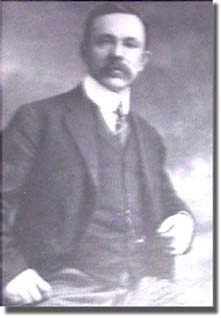 |
|
Joseph Nelson Rose
(1862-1928)
Photograph from Zeitschrift für Sukkulentenkunde |
Joseph Nelson Rose was born on the eleventh
of January, 1862, on a small farm in Union County, near Liberty, Indiana.
His father, George W. Rose, served in the North Army during the Civil War
and died at camp in Vicksburg, Mississippi. Rose's mother Rebecca was thereby
left to raise him through his early years. Very little information exists
from the years of Rose's youth; no major biography has ever been published.
To most, the image of J.N. Rose is merely that of a name succeeding that of
the illustrious New York botanist, Nathaniel
Lord Britton, with whom he is often associated in the team-title "Britton
& Rose." Rose's unique character, defined by its modesty and determination,
was most appreciated by those who knew him best, his colleagues and friends.
From their acknowledgments and his written correspondence, the name Joseph
N. Rose blossoms into an individual that not even William Shakespeare could
universalize.
The first documentation of Rose's germination, after the certification of
his birth, was a Liberty High School diploma. From there, he entered the preparatory
department of Wabash College in 1880 and matriculated as a full-time student
in the subsequent year. Rose graduated from the small, Indiana men's school
with an AB degree in 1885, followed by an AM in 1886. At this time, he decided
to begin part of his post-graduate studies under Professor John Merle Coulter,
the first of many noteworthy botanists to emerge from Wabash. This was also
the first time that Rose's steady, back-burner personality molecules were
excited. The student-teacher duo published "Revision of the North American
Umbelliferae" in December 1888, and in 1889 Rose garnered his Dr. phil. From
the years 1887-1900, Rose published several other works on other geographical
regions inhabited by the Umbelliferae, culminating in "Monograph of the Umbelliferae"
on 31 December 1900. All of these publications, classifying such spice and
herb species as dill (Anethum), caraway (Carum), fennel (Foeniculum),
and coriander (Coriandrum), included Coulter as co-author. According
to "The Biographical Memoir of J. M. Coulter," Rose was considered Coulter's
"most productive student in the systematic field… (often) …tempting his teacher's
diagnostic technique into further investigation of taxonomic relationships."
(Trelease, 1930) The written correspondence between the two men, documented
in the Smithsonian Archives, also illuminates the professional character of
Joseph Nelson Rose. While Coulter's investigations seemed rooted in biology,
Rose remained rigidly adhered to descriptive analysis of distinctions between
species. This juxtaposition, existing between the interests and procedures
of the two scientists, was noted by Richard Cowen and Frans Stafleu. In "Brittonia",
they described Rose as "the work-horse" and Coulter, "the quality-control"
(1981). From such testimonies of those associated with Rose, his dependable,
reserved personality becomes apparent.
In August 1888, Rose married Lou Beatrice Sims of Delphi, Indiana, with whom he created a large family comprising sons Joseph Sims, Walter, and George, and daughters Rebecca, Martha, and Deane. It was also during this year that he moved to 1883 Third Street, N.W., Washington, D.C., and began his professional career, entering a position as assistant botanist at the United States Department of Agriculture (USDA). Rose worked under the authority of George Vasey, but would soon emerge as a valuable independent asset to the institution. At the USDA, Rose's interests were immediately piqued by the succulent plant collections made by Edward Palmer. This became Rose's introduction to the flora of Mexico and Central America, and by 1897, Palmer invited him on an expedition during which he introduced him to the art of field work and the collecting technology of the time. The product of Rose's study at the USDA, "Studies of Mexican and Central American Plants," was published between the years 1897-1911. The historical collection material used for the investigation, i.e., boxes and trunks of photographs and manuscripts from Palmer's research, were dispersed from the Smithsonian and auctioned soon after Palmer's death. This action, performed under the direction of Rose, demonstrates his lack of appreciation for ungainly, erstwhile knowledge in the path of original, systematic progression.
In 1896, the National Herbarium was returned to the branch of the Smithsonian Institution known as United States National Museum. During this year, the USDA relocated Rose, changing his position to assistant curator of botany. He was promoted to associate curator in 1905, in which position he would begin the ascent to the peak of his career. Between the years 1903 and 1909, he held numerous vice-presidential roles amongst the scientific and botanical groups of Washington, Botanical Society (1903), Washington Botanical Society (1907), Washington Academy (1908 & 1918), and the Washington Biological Society (1909-1917, president 1918). Cultivating his interests in the Crassulaceae and Cactaceae families, Rose visited Mexico nine times during his role as associate curator. Sending living specimens to the greenhouses of the USDA and the New York Botanical Garden would lead to an alliance with Nathaniel Lord Britton. The two men were considered the world's experts on the Crassulaceae, publishing numerous works cooperatively.
In 1912, after obtaining an unpaid leave from the Smithsonian Institution, Rose began collaboration with N.L. Britton and Washington's Carnegie Institution on a monograph that would set the standard in cacti botany. The four-volume product, "The Cactaceae," was completed in parts between June 1919 and December 1923, requiring over twice the amount of time that was estimated in the second grant proposal. (The original proposal to catalogue only the species of the United States was broadened by New York Botanical Garden Laboratory Director, Daniel T. MacDougal, to include all the world's Cactaceae). This time span, however, is rather efficient when considering the amount of work involved. First off, Rose and Britton collected and studied more than quadruple the number of genera (from 21 to over 100) that were treated by Professor Schumann in his evaluation of the family in 1899. Secondly, the path of expedition led Britton and Rose from the European herbaria and botanic gardens (1912), where they obtained samples of cultivated species, to the West Indies (1913), Chile, Peru, and Bolivia (1915), Argentina and Brazil (1916), and Venezuela and Ecuador (1918). About a dozen other collectors, such as Joseph Adolf Shafer and Daniel Trembly MacDougal, accompanied Rose and Britton in the West Indies and parts of South America. Finally, in 1922, Rose visited his long-time correspondent, Alwin Berger, in his private herbarium in Mortola, Genoa, Italy, where he was received as "one of the most unselfish and kind-hearted men he (Berger) had ever met (Cowan & Stafleu, 1981 (p. 288))."
The meticulous diagnoses of "The Cactaceae" are illuminated by the delicate artwork of Miss Mary Eaton who, working for $300/year, adorned the pages with illustrations of plant life using a medium of vivid watercolor and precise line. The written work of Rose and Britton was considered by many contemporaries, such as Lyman Benson, to be the apex of "local liberalism endemic in the United States in the period from 1900-1930." He continued to state that if the rest of the generic hairs of the plant kingdom were to be split as fine as [they] had split those of the cacti, "at least one million changes in plant names would be required" (Benson, 1940-50). This system of fragmenting the antiquated system of "collective genera" into neoteric, more refined "generitypes" was imperative in the treatment of the family Cactaceae. In the beginning of the 20th century, the taxonomy of these succulent plants was the product of perpetual errors of identification, description and geographical location. Species names had been transferred where they did not belong, and generic names were assigned without regard for systematic priority. After Britton and Rose's elucidating publication, a renaissance of interest in the family began and grew worldwide. In Europe, cactus seed and plant dealers were in high demand, while gardeners of the Americas began contributing homegrown specimens to the collections at the N.Y. Botanical Garden and the U.S. National Museum for study. Today many of the original voucher specimens, picked and dried, are available in the NYBG herbarium for further systematic study of this salient family. The legacy of Rose and Britton's work continues to prick the interests of experts like Alberto Areces-Mallea, Gabriela Ocampo, other world-class botanists, and assistants like myself.
"The Cactaceae," however, is not the only publication where these two men are noted for performing such refined, systematic assessments.
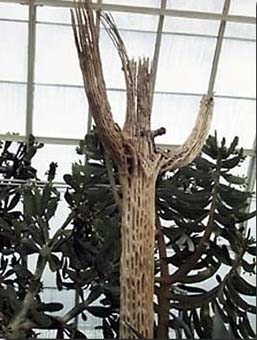 |
|
Skelaton of the
"Great Saguaro Cactus," Opuntia gigantea, surrounded
by the blooming Opuntia collection from the Rose & Britton's
expedition.
|
And, as observed in the previous character sketch of Rose, the mind behind these elegant taxonomical treatments is often that least credited. For example, in Britton & Rose's publication in "North American Flora", the collective genus Cassia is divided into twenty-seven genera. Species of Cassia include C. javanica (a tropical timber used for building houses in Java), as well as C. fistula (which bears a fruit reaching 60 cm in diameter with a pulp that is used as a laxative). Due to the work of NYBG botanists Howard Irwin and Rupert Barneby, the genus is now systematically condensed to include only a few genera, but during Rose and Britton's investigations Cassia species were extremely undefined taxonomically. When "The Cactaceae" work was terminated, Rose returned to work at the Smithsonian, and again collaborating with Nathaniel Lord Britton, he began study of the families Caesalpiniaceae and Mimosaceae. For the next few years, the two exchanged letters and views on the families, particularly the genus Cassia. During this time Rose was concentrating his studies on the Caesalpiniaceae (the family containing Cassia), while Britton was primarily concerned with the Mimosaceae. Rose had also been exposed to many Cassia species during his numerous trips to Mexico, and can therefore be considered as equally (if not more) authoritative on the genus as Britton. In the following years, "North American Flora" was published, and though some segregates of Cassia, such as Sericeocassia, Xerocassia, Tharpia, and Earleocassia, were coined under the team Britton & Rose, others were ascribed to Britton alone. Furthermore, two years after Rose's death, Britton published "Studies of Puerto Rican Flora", a book that also contained the meticulous research of Joseph Nelson Rose. A December 6, 1922 letter, in the Smithsonian Archives, written by "a greatly interested" Nathaniel Lord Britton, implores Rose's conclusions concerning the genus Cassia "in time for me to use them in the Porto Rico Flora." From this as well and many other, documented, Smithsonian correspondences, it is clear that Britton had indeed esteemed Rose's notions on the genus Cassia. "Studies of Puerto Rican Flora", however, had only one author following the elusive segregates of the Cassia genus, that of course being Nathaniel Lord Britton.
Joseph Nelson Rose passed away on 4 May 1928, but not before becoming a legend. An Argentine journalist, Alberto Castellanos, scribed Rose's obituary in a June issue of "Physis" as "perdiendose con el a una de las autoridades mas altivas en la taxonomia de la curiosa familia de la flor americana, la Cactaceas." Rose is also remembered for his work with the Crassulaceae, Umbelliferae, and Amaryllidaceae and was awarded the highest honor in botany by several scientists for his efforts: Dr. Sereno Wilson named for him the genus Rhodoscadium (1890), Professor Cogniaux the genus Roseanthus (1896), Dr. Small the genus Roseanthus (1910), and Mr. Alwin Berger the genus Roseocactus (1925). Working mostly with others, Rose published nearly 200 botanical papers and books, ranking him among the elite of such accomplished and cooperative botanists. It is ironic that such an ostentatious name as "Rose" was used to identify such a modest, reserved man, who spent the better part of his sixty-six years scrutinizing eccentric succulents. Maybe Shakespeare was correct in his assumption: Perhaps a rose by any other name still would smell as sweet… And maybe, if Joseph Nelson had been differently named, he would still have aptly pollinated the field of botany.
Books:
Benson, Lyman D. 1940-1950. The Cacti of Arizona. University of Arizona Press, Tuscon.
Benson, Lyman D. 1982. The Cacti of the United States and Canada. Stanford University Press, Stanford.
Britton, Nathaniel L. & Rose, Joseph N. 1919. The Cactaceae. The Carnegie Institute Press, Washington D.C.
Conville, Fredrick V. 1904. Desert Plants as a Source of Drinking Water. Government Printing Office, Washington.
Harborne, Jeffrey B. & Baxter, Herbert. 1996. Dictionary of Plant Toxins. John Wiley and Sons Ltd., West Sussex (England).
Little, John R. & Jones, Eugene C. 1980. A Dictionary of Botany. Van Nostrand Reinhold Company, New York.
Mabberley, D. J. 1997. The Plant Book. Second Edition. Cambridge University Press, Cambridge.
Morton, Julia F. 1981. Atlas of the Medicinal Plants of Middle America (Bahamas to Yucatan). Charles C. Thomas Publishers, Springfield (Illinois).
Raven, Peter H., Evert, Ray F., & Eichhorn, Susan E. 1999. Biology of Plants. Sixth Edition. W. H. Freeman and Company/Worth Publishers, New York.
Schumann, Karl. 1899. Monographia Cactacearum. Neumann Publishers, Neudamm (Germany).
Journals & Periodicals:
Berger, Alwin. 1927-1928. Joseph Nelson Rose. Zeitschrift fur Sukkulentenkunde 3: 281-283.
Cowan, Richard S. & Stafleu, Frans A. 1981. Rose and Britton: From Brittonrosea to Cassia. Brittonia 33: 285-293.
Trelease, William. 1930. Biographical Memoirs. "John Merle Coulter, 1851-1928" National Academy of Sciences 14: 4th Memoir.
Castellanos, Alberto. 1928. Physis 9: 154-155. Sociedad Argentina de Ciencias Naturales, Buenos Aires.
Who's Who In America. 1897-1942. Volume 1: Biographies of the Non-Living.
Climbing
and Columnar Cacti: New Arid Land Fruit Crops
-An experiment by Yosef Mizrahi and Avinoam Nerd
Thanks To:
The New York Botanical Garden Staff: Jackie
Kallunki (editor and supervisor), Kevin Indoe (web wizard),
Gabriela Ocampo (fellow cactologist and cultivator),
and Robert Berner (conservatory gardener).
Lehman College Greenhouse Manager: David Cain
Assistant Photographer: L. Manchester
